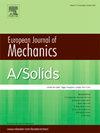基于晶体塑性的直接法及其在增材制造AlSi10Mg材料安定极限预测中的应用
IF 4.2
2区 工程技术
Q1 MECHANICS
引用次数: 0
摘要
在增材制造设计(DfAM)的框架下,建立包括多晶和缺陷在内的微结构与多晶合金材料疲劳性能之间的联系是至关重要的。虽然Dang Van已经弄清楚了材料的多尺度振动与疲劳强度之间的关系,并且已经开发了几种多尺度直接方法(DM)并应用于各种材料,但目前现有的DM主要集中在von Mises或Drucker-Prager材料上,不能反映多晶的微观结构。为此,本文开发了一种基于晶体塑性的直接方法,称为CP-DM。该方法将下界定理与速率无关的晶体塑性本构模型相结合,并应用于激光熔化沉积(LMD)制备的多晶材料AlSi10Mg。在增量分析证实了该方法的有效性后,利用该方法预测了材料的安定极限,并利用多个统计等效代表体积元(SERVE)模型研究了制造过程中引入的孔隙缺陷的影响。在考虑LMDed AlSi10Mg材料的运动硬化时,还考察了CP-DM的有效性,并研究了硬化行为对强度的影响。研究表明,所建立的CP-DM方法是预测增材制造技术制造的多晶材料,特别是金属材料疲劳极限的一种可行手段。本文章由计算机程序翻译,如有差异,请以英文原文为准。
A crystal plasticity based direct method and its application in predicting the shakedown limit of an additively manufactured AlSi10Mg material
In the framework of Design for Additive Manufacturing (DfAM), it is crucial to establish a connection between microstructures including polycrystals and defects, and the fatigue performance of polycrystalline alloy materials. Although Dang Van has already figured out the relationship between multiscale shakedown and the fatigue strength of the material, and several multiscale direct methods (DM) have been developed and applied to various materials, so far existing DMs mainly focus on von Mises or Drucker-Prager materials and cannot reflect the microstructures of the polycrystals. To this end, in the present paper we developed a crystal plasticity based direct method called CP-DM. The method integrates the lower bound theorem with a rate-independent crystal plasticity constitutive model and it is applied to an exemplary polycrystalline material AlSi10Mg made by laser melting deposition (LMD). After the validity of the method is confirmed by incremental analyses, it is employed to predict the shakedown limits of the material and investigate the influence of pore defects introduced during the manufacturing process using many statistically equivalent representative volume element (SERVE) models. The effectiveness of CP-DM is also examined when considering the kinematic hardening of the LMDed AlSi10Mg material, and the impact of the hardening behavior on strength is investigated. The study shows that the established CP-DM method can be a viable means to predict fatigue limit of the polycrystalline materials and especially metallic materials manufactured by additive manufacturing techniques.
求助全文
通过发布文献求助,成功后即可免费获取论文全文。
去求助
来源期刊
CiteScore
7.00
自引率
7.30%
发文量
275
审稿时长
48 days
期刊介绍:
The European Journal of Mechanics endash; A/Solids continues to publish articles in English in all areas of Solid Mechanics from the physical and mathematical basis to materials engineering, technological applications and methods of modern computational mechanics, both pure and applied research.

 求助内容:
求助内容: 应助结果提醒方式:
应助结果提醒方式:


